From Paris to the Mediterranean and the Pyrenees
RAILWAYS OF EUROPE - 21
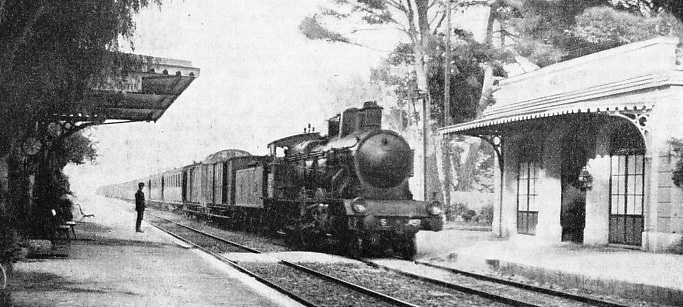
ON THE MAIN LINE OF THE PLM - the Paris, Lyons and Mediterranean Railway - a Mentone to Paris express passing through the station of St. Augustine, near Nice. The famous “Cote d’Azur Pullman” covers the journey of 689 miles between Paris and Mentone in thirteen hours.
OF the six main-line railways serving the French republic the greatest is the Paris, Lyons and Mediterranean, or the PLM as it is almost universally known. Though the PLM may be thought to have lost its pride of place since January 1, 1934, when the Paris-Orleans and Midi Railways began to be operated as one concern, it is still France’s greatest railway. The Paris-Orleans-Midi lines have a route mileage of 7,270 in France, and the PLM has a route mileage of only 6,960, including 786 miles in Algeria and Morocco. But the constituent companies of the Paris-Orleans-Midi system still retain their separate corporate identities, and so the PLM has not really been displaced.
The PLM is linked with the beginning of railway history in France, for it was between Lyons and St. Etienne, in the depart-ments of Rhone and Loire, that the pioneer French railway was opened in 1828. On this line, which at first was worked by horse traction, Marc Seguin tried his celebrated forced-draught locomotive, in which huge rotary fans provided the draught instead of the then unknown blast pipe. The main foundation of the present great system consists of the line from Paris to Macon and its deviations through the Alps to the Italian frontier and down the valley of the Rhone to Marseilles and the Mediterranean coast, where it meets Italy again between Mentone and Ventimiglia. Over these lines, for years, the company has run some of the finest and most famous trains in the world, including the mail trains to Marseilles, and the series of Riviera expresses which have long been a household word in many countries.
At Paris the PLM is linked up with the other trunk lines, with the natural exception of the Alsace-Lorraine Railways, by the circular lines of the Ceinture Railway Company. To the south of Paris, PLM territory marches on the eastern side with the Eastern Railway, and on the western side with the Paris-Orleans-Midi lines.
The geographical position of the PLM makes it a vitally important international link. Through carriages run to the Gare de Lyon, the PLM station at Paris, from Channel ports on the Northern and State lines. At Paris they form part of the famous international trains, many of them running through Switzerland to Italy and to Eastern Europe. Among these are the Rome Express and the Simplon-Orient Express.
Along the south coast through workings take place with the Paris-Orleans-Midi lines between Ventimiglia and Hendaye on the Spanish frontier. A good general idea of the system will be obtained by making a real or imaginary journey over the main line which gives the PLM its name, that from Paris to the Riviera.
The town of Laroche, ninety-six miles from Paris (Lyon), is the first stopping place for every one of the south-bound expresses, and just under a hundred miles farther south is the famous city of Dijon. Lines radiate from Dijon in various directions, for it is a junction for Alsace and Switzerland as well as for Italy via Dole and the Simplon Tunnel. The main trunk line, however, continues ever southward through Chalon-sur-Saone to Macon, where, as stated above, the Mont Cenis (Modane) route to Italy diverges, and whence an important line runs across to the Swiss frontier near Geneva. Macon is 273½ miles from Paris. Lyons (Vaise Station) is 315 miles from Paris, but the principal station (Perrache) is three miles farther on.
Lyons is really the hub of the PLM system from a territorial point of view, and cross-country expresses reach it from places as far afield as Munich. It is at Lyons that the line reaches the great River Rhone, having entered the valley of its tributary, the Saone, between Dijon and Chalon. Following the river, the line continues in a southerly direction, with lines on either side, as on the German State Railway route up the Rhine.
The historic city of Avignon is situated 461 miles from Paris, the distance being roughly the same as from London to Perth via Glasgow. In the middle ages, during the period of the “Babylonian captivity” - from 1309 to 1377 - Avignon was a city of the Popes, and even to-day it is one of the most perfect examples of a medieval town in Europe, with its huge battlemented walls and cathedral-crowned rock. The Papal influence survived for long after the fourteenth century, when it was at its height, and it was not until as late as 1791 that Avignon became a purely French city. After another fourteen miles, the PLM reaches Tarascon, which is a junction for Séte (Cette) and Narbonne on the Midi line, through connexion being maintained even with Barcelona. Here, in Provence, we are well into one of the most important territories of the ancient Roman Empire, and at Arles it is possible to see the remains of many Roman buildings, including a still intact amphitheatre capable of seating 24,000 people. The town was the capital of the kingdom of Arles in the tenth century. Finally, after running through Rognac, the PLM reaches the great maritime city of Marseilles, 536 miles from Paris. Marseilles is the second city of France, having rather over 800,000 inhabitants, but though it is the same as the ancient Roman city of Massilia, it is modern in appearance, and has none of the characteristics of Arles and Avignon. Both as a railway centre and as a seaport, its traffic is very great, and it forms the centre point for Mediterranean commerce. From the St. Charles Station at Marseilles, the famous Riviera line bears eastwards along the coast, past Toulon, the second largest naval station in the country, and the terminal point for many of the local trains running along the coast via Cannes, Juan-les-Pins, and Antibes to Nice. In spite of its fame as a fashionable resort, Nice is large rather than beautiful. Beyond Nice comes the loveliest stretch of line along the whole of the route from Paris, especially welcome after the long stretch between Arles and Marseilles, and the dry open country following that district. The train pursues its sinuous course along the rocky coast, below the Maritime Alps, past orange and lemon groves and beautiful sea-washed gardens.
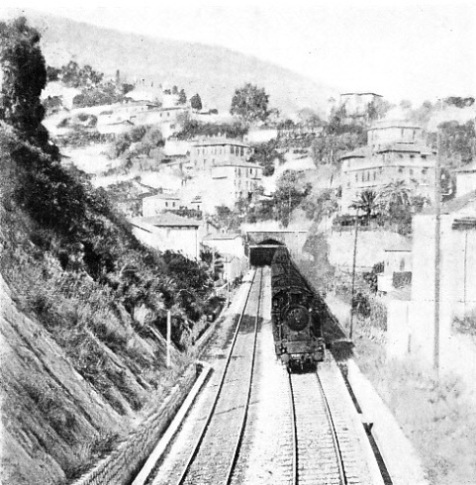 Below the great mountainous mass called the Tete du Chien, the line runs into the tiny Principality of Monaco, with the rock-crowned citadel on one side and the town of Monte Carlo on the other. The station at Monte Carlo lies almost underneath the terrace of the most famous casino in the world.
Below the great mountainous mass called the Tete du Chien, the line runs into the tiny Principality of Monaco, with the rock-crowned citadel on one side and the town of Monte Carlo on the other. The station at Monte Carlo lies almost underneath the terrace of the most famous casino in the world.
THE FRENCH RIVIERA, one of the world’s most famous holiday districts, is served by the main lines of the PLM. Here is a Ventimiglia-Paris train passing through Mentone.
For the remainder of its course, past Roquebrune and Cap Martin, the line passes through exquisitely beautiful scenery in which, from a railway point of view, a particularly exotic note is struck by the aloes and prickly pear which are used in some places to hedge the tracks on either side. The last station in France is Menton-Garavan, just beyond Mentone proper, but the PLM trains, local and express alike, generally run right through to the Italian frontier town of Ventimiglia, 697 miles from Paris via Marseilles.
The ordinary steam-hauled expresses of the PLM are not greatly distinguished for speed, though at the same time they are not slow. The special Bombay Express, running from Calais to Marseilles in connexion with the P. & O. steamers, appears from the time-table to make this very lengthy journey without a stop; but the train does halt a number of times for locomotive purposes. Both corridor tenders and track water-troughs are unknown on the PLM, though water-troughs may be seen on the State Railway in the North. The journey time of 13 hours 22 minutes is liberal, and the express, though one of the most comfortable trains in the world, is not inexpensive. The “Cote d’Azur Pullman” takes only thirteen hours for the 689 miles between Paris and Mentone, and ranks as the principal longdistance speed train on the PLM. Its point-to-point timings are detailed in the chapter “Speed Trains of Europe”. An express rail-car runs from Paris to Lyons in 4 hours 50 minutes for the journey of 317·3 miles. But this rail-car does not interest the Riviera passengers very much, for it does not run on to the coast.
A wonderful new line has recently been completed between Nice and Breil, a distance of twenty-eight miles. Breil is on the Italian frontier in the heart of the Maritime Alps, and from it a line of the Italian State Railways, constructed at the same time as the PLM branch, continues to Cuneo, forming a through connexion between Marseilles and Turin. From Nice this new line winds up into the mountains past the quaint old town of Sospel, beyond which an extraordinary series of tunnels and viaducts brings it into Italy. When the line is seen from the bottom of an adjacent gorge, it seems incredible that the engineers ever managed to build through such a district, and that, once built, it should stay in its precipitous position. The effect produced by the passage of a train might, in one or two places, be compared to the progress of a caterpillar along the side of some vast garden wall. The aspect of the work is too stupendous to allow for any condemnation of it as a “blot” on the scenery; for, though the station at Sospel may be thought to spoil the appearance of the valley, on the sections of the line where it penetrates the deep gorges its viaducts and grading make it a thing of majestic beauty.
This is only one of the great mountain lines of the PLM; but for the moment we must turn to an area much farther afield, namely, North Africa. Here we find the PLM working the main line from Algiers to Oran, 262¼ miles in length. Naturally, a frequent service between these outposts of the company is not a practical proposition, and there are only two through trains every twenty-four hours in either direction. One of these, which takes the whole day, includes a restaurant car; the other is a sleeping car “express”. The title is nominal indeed, for the train stops at nearly every station and takes about nine and a half hours on the way. The night train is preferable, for day travelling can be tedious under the rays of the African sun. The Algerian lines are described in detail in the chapter “In Northern Africa”.
Turning back to the Maritime Alps, we find the lines of the PLM being supplemented by a wonderful little metre-gauge railway, the Provence Railway’s South of France Line. This company has two separate systems, one from Toulon along the coast, the other with inland lines based on Nice. The trains are few and rather primitive, but the journey up from Nice to Vence and Grasse, with its passage of the great viaduct at Le Loup, not to mention several others, is one not easily forgotten.
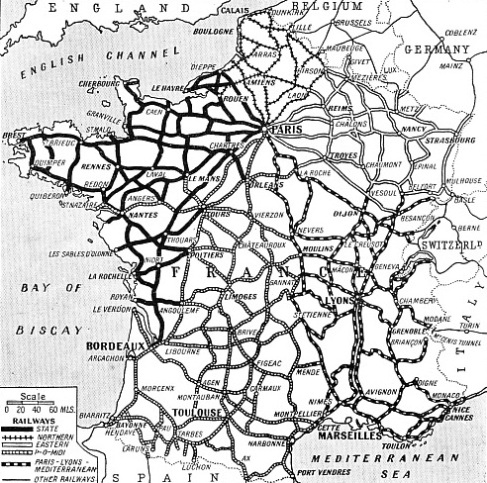
ALL THE MAIN RAILWAYS OF FRANCE with their routes are shown on this map. The Eastern Railway has some 3,189 miles of standard-gauge track open, the French State Railways 5,727 miles, the Midi 2,626 miles, the Northern Railway 2,485 miles, the PLM 6,960, and the Paris-Orleans Railway 4,404 miles. There is also a large number of smaller lines and narrow-gauge routes.
The PLM has always been well-provided by its locomotive department, though some of the older engines were of rather weird appearance to Northern eyes. Fifty years ago the Riviera expresses were being hauled by 2-4-2 locomotives, which were then among the most advanced and imposing in the country. Eight-coupled goods engines also appeared a long time ago, and the same general type, improved and enlarged as requirements demanded, remained the standard for years. For working in the long Alpine tunnels up to Modane, some of the early engines were fitted with a special respiratory apparatus for the drivers and firemen, by which fresh air was pumped on them during their passage through the sulphurous depths.
Streamlining of locomotives is normally considered as being one of the very latest developments in railway engineering, though an American engineer named Adams produced a partly streamlined train as far back as the ‘eighties of the last century. In the late eighteen-nineties and early nineteen-hundreds the PLM made a plucky though not entirely successful attempt to streamline all those of its locomotives which were engaged in fast passenger traffic. These engines attracted a good deal of attention in other countries, as well as in France, and became known as the “windcutters”.
To lessen the resistance of the atmosphere, the design incorporated a prow-shaped smoke-box door, faintly resembling the bows of an old-fashioned torpedo-boat. The cross-section of the chimney casing also showed it to come to a point in front, and sheeting united the chimney with the dome cover and sand-box. The dome, as in all PLM locomotives at that time, was very large, and usually had the safety-valves on top of it, and the general appearance was not elegant. The cab, in its turn, was brought to a point in front, and this last feature has survived into modern times.
Very much less was known then than now about the resistance of trains at high speeds, and, though large numbers of “windcutters” were built, the results aimed at can hardly be said to have been attained. Indeed, many of the enginemen said that the locomotives set up more resistance even than the ordinary type, and behaved in a most eccentric manner under certain conditions. “Windcutters” of both the 4-4-0 and 4-6-0 type were built, and as recently as 1921 they were occasionally used on important international expresses.
Turning to more recent developments, during the earlier part of the present century, an efficient type of 4-6-0 locomotive, the 230-C class, was introduced for express passenger traffic. Though of moderate size, engines of this class were recently to be seen on the heaviest trains in the south. Some have been transported to Algeria, and work some of the main-line trains running between Algiers and Oran, for which they are eminently suited. Large “Garratt” articulated locomotives, nevertheless, are now appearing in Algeria.
First of Its Type
The modern “Pacific” type had made its appearance on the PLM before the war of 1914-18, and engines of this type, fitted with superheaters and improved generally, remained the largest on the system until the recent advent of the 4-8-2 “Mountain” type engines, similar to those first introduced by the Eastern Railway of France during the nineteen-twenties. In tank engine design, a 4-6-4 class, corresponding to the 230-C series of 4-6-0’s, has given place to a not dissimilar, though greatly enlarged, class with the 4-8-4 wheel arrangement.
In 1930 there appeared a 4-8-2 express locomotive with a Schmidt-Henschel super-high-pressure boiler. Similarly to the ordinary eight-coupled express engines, this was a four-cylinder compound, but the high-pressure cylinders used steam at no less than 882 lb per sq in, the figure for the low-pressure cylinders being 206 lb per sq in. This locomotive was built by Henschel & Son, of Kassel, being one of the very few engines built in Germany for French service. Some of the “Pacifics”, however, originated at Kassel also, and there are, of course, many German locomotives which were handed over to French railways as reparations stock after the war. Finally, during 1935 a completely streamlined steam train has appeared on the PLM, the first of its type in Europe to take the rails. Time will show what degree of success it attains, but with the promise of proper scientific research it is probable that there will be more said in its favour than there was for the “windcutters” of 1900.
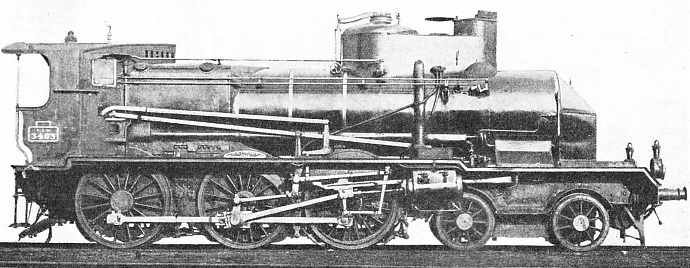
A “WINDCUTTER” ON THE PLM. Early examples of streamlined locomotives were built in large numbers at the end of the nineteenth century. The design included a prow-shaped smoke-box door, a chimney combined with the dome cover and sandbox, and a cab with pointed front. “Windcutters” of both the 4-4-0 and 4-6-0 type were built in considerable numbers.
Though the Paris-Orleans-Midi comes easily first in France in the matter of main-line electrification, the PLM has done noteworthy work in this direction. Some attention is given to this field of its activities in the chapter on the “Rome Express” . As far back as 1901, the St. Gervais and Valorcine electrification was carried out, with current supplied at 600 volts DC by means of third-rail contact, a system which is the commonest in Great Britain to-day. It was not until 1925 that a start was made with the eminently suitable mountain main line from Chambery to Modane. On this line the third rail was retained, except at important stations, where overhead contact was provided, but current is supplied at 1,500 volts. The trains are hauled by heavy electric locomotives, as on the Swiss and other existing Alpine lines.
By reason of the heavy passenger traffic to the Riviera, which attracts many visitors who travel first class, PLM passenger rolling stock has always been interesting. The company was an early user of sleeping cars, and to-day it operates various vehicles of its own design in addition to those provided by the International Sleeping Car Company. The cars of the International Sleeping Car Company have received their meed of attention in this work, and need no further description in this chapter. The PLM vehicles are less orthodox.
Accommodation in Couchettes (literally “Small Beds”), which is found elsewhere in France as well, is not dissimilar to that provided by the standard British third-class sleeper, except in the matter of price, which is not low. During the day the top berths fold up, turning the compartment into an ordinary “first”. The Couchettes-Toilette is the same, with the addition of a wash-basin. Then comes the Lits-Salon (literally “Beds-Saloon”), which is a comfortable arrangement. The seats pull out to form longitudinal beds at night, the passengers lying parallel with the side of the coach instead of across it. In the better class of Lits-Salon private lavatories are provided. It all depends on what the passenger is prepared to pay. The Canapes-Lits (literally “Sofa Beds”) are spacious compartments containing two convertible berths, forming comfortable sofas by day and equally good beds at night. One such compartment may be found in a Lits-Salon car. Third-class sleeping accommodation is provided on some of the International cars, but it is inferior to that on the British railways.
Rolling Stock on the PLM
The ordinary first- and second-class coaches on the PLM are distinctly good, being superior to those on the neighbouring Italian lines, though comparing less favourably with similar vehicles in Germany and Switzerland. On the express trains the third-class carriages are now quite comfortable, with well-designed leather seats, though the extreme plainness of their appointments is rather cheerless at times, especially on night journeys. As far as body-construction and springing go, on the other hand, all the more recent coaches are beyond reproach, and even some of the coaches in use on local traffic are better than the majority of Continental passenger vehicles of this kind.
Third-class carriages are painted dark green, second-class yellow and black, and first-class crimson and black. This system of distinctive colours for different classes of vehicle is a relic of quite early days, and has passed into disuse on the majority of the world’s railways. It rather tends to spoil the aspect of the trains, and when a blue International car and, say, a light green Alsace-Lorraine car find their way into the make-up, a train’s appearance is patchy in the extreme.
The attractive International trains, such as the “Cote d’Azur Pullman”, referred to earlier in this chapter, are finished in blue and cream, and a welcome contrast to the ordinary trains.
Though the Paris-Orleans and the Midi are now virtually one system, their working agreement is so recent that it is still easier and simpler to deal with them separately. It is also interesting to record their separate characteristics before their individuality sinks, as it doubtless will under the Paris-Orleans-Midi common denominator. The Paris-Orleans Company, as it was, began its main line in the low-level station of Quai d’Orsay. From the time of its opening, the stretch of underground line intervening between this and the older Austerlitz Station was electrically worked, the change-over to steam - for express trains - being made at the Austerlitz Station in the old days. This no longer applies now that the whole of the northern main line is electrified.
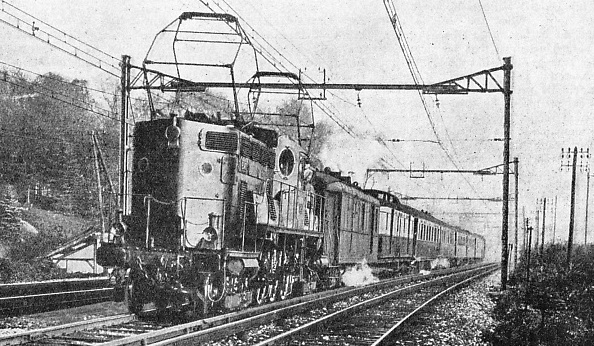
THE “SUD EXPRESS” of the Paris-Orleans-Midi line, being hauled out of Paris by a 4-6-4 electric locomotive. The Midi and the Paris-Orleans Railways began joint operation in 1934. The two companies have over 1,200 miles of track electrified, and further conversions are in progress.
The Orleans line from Paris to Bordeaux is that followed throughout by the renowned “Sud Express”, so a further detailed account of its course is superfluous in this chapter. But from it there diverge two other important main lines which belonged to the old Orleans Railway. The first of these turns southwards from Orleans, on the Loire, to Vierzon, 127 miles from Paris. Thence the route serves the important town of Limoges, whose history goes back into the mists of the past, for it was originally the stronghold of a Celtic tribe called the Lemovices before it became Latinized under the Roman Empire.
Beyond Limoges lies Brive, 313 miles from Paris. Though now a modern manufacturing town with fine tree-planted streets, the site of Brive, similarly to that of many a town in France, in addition to Limoges, is of great antiquity. At Cahors, 375 miles from Paris, we find another wonderful old town full of Roman remains. From Cahors the line passes down through Montauban to its destination at Toulouse, where, 445½ miles from Paris, it meets the old Midi system, now a continuation.
The western main line of the Orleans diverges from the central Bordeaux line near Tours, and runs down the lower Loire valley to Nantes and St. Nazaire, linking up to a great extent with the French State Railways. Both State and Orleans trains serve the shores of the Bay of Biscay between Bordeaux and Nantes. Some 280 miles of the former Paris-Orleans lines in Brittany have been transferred to the administration of the French State Railways.
The distance from Paris to Nantes is 124 miles, and Le Croisic, fifty-four miles farther on, is the normal terminal point for the Orleans trains over the Nantes line. Since January 1, 1934, Brest has been a preserve of the State Railways; the Paris-Orleans-Midi monopolizes Bordeaux as far as the through traffic to Paris is concerned, though the State Railways have a line running via Saumur. At the time of its fusion with the Midi in 1934, the Orleans company possessed 4,404 miles of standard gauge line, with an additional narrow-gauge mileage.
A considerable mileage of route had been converted to electric working on the DC system at 1,500 volts, similar to that of the PLM, but with overhead conductors throughout. The old “P.O.”, as it was called before the amalgamation, was for long a railway renowned for the speed of its express trains. The electrification of a lengthy stretch of the main line down from Paris resulted in an even better service over the lines concerned. The present electric system was inaugurated in 1924, in which year the original 600 volts third-rail system between Paris and Juvisy, carried out at the beginning of the century, was converted to the present standard. But the fastest timing on the Paris-Orleans-Midi is made by a steam-hauled train, from Poitiers to Angouleme, seventy miles in one hour, start to stop.
Progress of Electrification
This and other Paris-Orleans-Midi runs are dealt with in the chapter on “Speed Trains of Europe”. The electrified area of the Orleans main line is being steadily extended, and it is difficult to forecast ultimate developments, though an attempt has been made in the chapter, “Electrification in Europe”. Naturally, some of the fine Orleans steam locomotives which electrification has displaced are far too good, yet, for scrapping, and 370 of these have been transferred to other French railways, and also to Algeria, where they are doing very well. But even in Algeria electrification has begun with the equipment of over sixty-seven miles of route on the State Railways.
At the end of the last century the locomotives of the Paris-Orleans were similar to those of the PLM in general design, but not quite so heavy and uncompromising in outward appearance. “Wind-cutting” was not attempted. There were express passenger engines of the 2-4-2 type, and large numbers of generally similar machines of slightly smaller dimensions, lacking the trailing axle. They were not beautiful, at least to British eyes. An average specimen had a very tall chimney with a lid to it, and an enormous dome, surmounted by a pair of Salter safety valves, set in a position just calculated to upset the engine’s outline. For all that, they did very good work and some are still in service on country local services. The 2-4-2 type, except for tank engines, never found favour in Great Britain, though it appeared a great deal on the Orleans and the PLM, and also on the Belgian railways.
Much larger locomotives appeared even in the early years of the present century, including an improved type of De Glehn four-cylinder compound, similar to, though larger than the type then appearing on the Northern Railway of France. When the eight-coupled “Mountain” type engines were appearing elsewhere in France, the Orleans, similarly to the Northern, remained faithful to the smaller 4-6-2 “Pacific” type for its steam-hauled express services. Some of these have recently been rebuilt to conform with the latest requirements of the day. As rebuilt, they are externally distinguished by double chimneys.

A “MOUNTAIN” TYPE express locomotive of recent design, now operating on the PLM Railway. This powerful type of engine has been known to haul a 500-tons train at high speeds over difficult gradients.
The earliest electric locomotives were of the eight-wheeled double-bogie type, somewhat resembling those which haul the through Southend trains over the District line in London. With the initial main-line electrification in 1924, there appeared double-ended bogie electric locomotives with two sets of four-coupled wheels, but recent practice has shown the advantages of eliminating side-rod drive in favour of geared transmission.
A long time before the war, the Orleans Railway was noted for the fine equipment of its Paris-Bordeaux expresses, and the “Sud Express” had the reputation of being the most comfortable train in the world. The “Sud Express” is now composed of Pullman-type saloon cars belonging to the International Sleeping Car Company, but for internal services, the amalgamated Paris-Orleans-Midi has some very fine rolling stock, maintaining the good reputation of past years.
The majority of old Midi coaches were not notable for any great degree of excellence, but on through trains there were quite good bogie corridor coaches.
The Midi Railway Company, before its amalgamation with the Orleans, was in some ways a continuation of the latter, and in others a buffer-state between it, the PLM, and the Northern Railway of Spain. One feature which the Midi Railway has held in common with certain lines of the State Railways, during the present century, has been the use of bull-headed rails laid in chairs. On almost all other railways on the European continent the flat-bottomed Vignoles rail has been standard throughout living memory. But flat-bottomed rails are now becoming standard throughout the Paris-Orleans-Midi system.
The main system of the former Midi Railway serves some of the most fascinating and beautiful localities in France. The line forming a connecting link between the Paris-Orleans at Bordeaux and the Spanish frontier between Hendaye and Irun begins with the famous Bordeaux-Dax section, ninety-two miles long; for years a famous speeding ground. Hendaye is 145 miles from Bordeaux, and thence for the remaining two miles across the frontier into Irun, the standard gauge French track and the broad gauge Spanish track overlap one another, running side-by-side, together with a narrow-gauge line. The effect is peculiar.
The east-to-west main line of the old Midi system connects Bordeaux with Sete on the PLM, 296 miles on the way to Marseilles, and serves on its way Montauban and Toulouse, thus linking up with the Orleans line again and completing its final lap. A little over fifty-five miles farther east, Carcassonne is reached, with its grim citadel frowning over the town below. Thence the line passes through Narbonne and Beziers before reaching Sete. Through coaches run over this line to Marseilles and Ventimiglia for Italy and Eastern Europe.
Both the PLM and the Orleans-Midi carry a considerable proportion of France’s freight traffic, and the PLM serves the important industrial area near Lyons.
Two coast lines running into Spain via Hendaye and Cerbere respectively, date from 1864 and 1878; but in 1928 the Somport Tunnel through the Pyrenees, 4 miles 1,572 yards from portal to portal, was officially opened for traffic. To-day, as a result, the railway distance between Toulouse and Barcelona has been shortened by no fewer than sixty-six miles. The Franco-Spanish break-of-gauge occurs at Canfranc, on the Spanish side of the tunnel, and 3,817 feet above sea-level. The tunnel is the longest on any French railway, and is worked by electric traction. The ascent to the tunnel is indescribably grand, whether from the French or from the Spanish side, but it is rivalled by another new trans-Pyrenean route, which has come into being by the extension of the existing Ax-les-Thermes branch up the Aridge valley, which included the construction of a mile-long spiral tunnel at Saillens. The frontier is crossed at La Tour de Carol, after topping a summit-level of 5,200 feet.
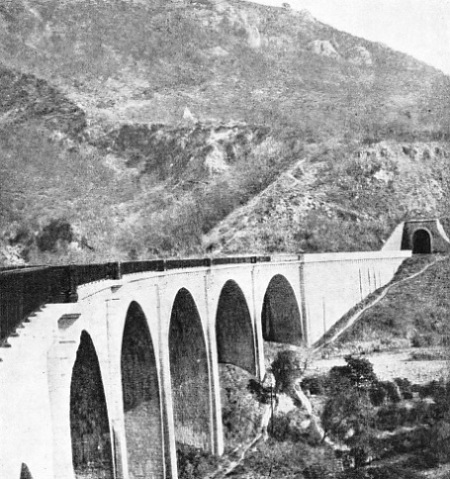
LE LOUP VIADUCT on the Provence Railway in Southern France. This railway has 295½ miles of track open, possesses 67 locomotives, 158 carriages and 1,215 wagons.
The Midi was a pioneer in main-line electrification, and made a start by equipping some seventy miles of line on the single-phase system at 12,000 volts, 16·7 cycles. Operations started in 1910, but the lines in question have since been converted to the usual 1,500 volts DC system, and altogether nearly 1,000 miles of route were so worked by 1934. The electrified mileage is still increasing under the amalgamated companies’ regime.
In the face of such figures as these, it might well be expected that here steam traction has taken something of a back seat. At the time of the amalgamation, the Midi had 2,626 miles of standard-gauge line and thirty-nine miles of metre-gauge line, so it will be realized from the figures in the preceding paragraph how great has been the extension of the use of electric traction.
You can read more on “From Brittany to the Rhine”, “A Link with the Mediterranean” and “The Northern Railway of France” on this website.




 Below the great mountainous mass called the Tete du Chien, the line runs into the tiny Principality of Monaco, with the rock-
Below the great mountainous mass called the Tete du Chien, the line runs into the tiny Principality of Monaco, with the rock-



